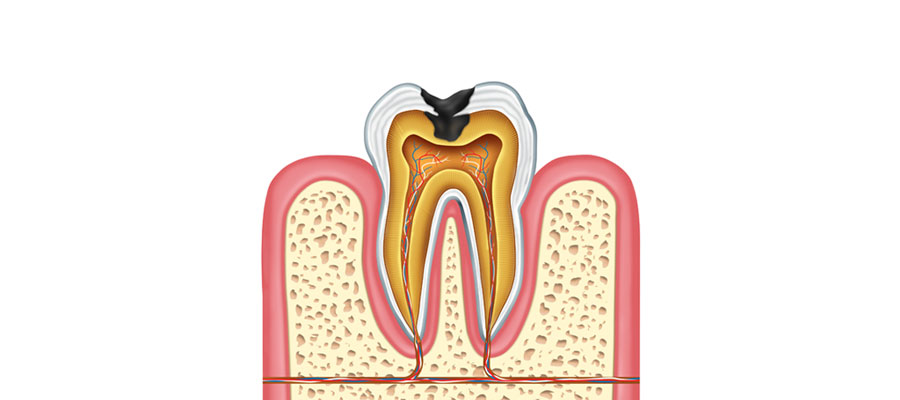What does dental caries therapy include?
Tooth decay is a condition in which bacteria in the mouth feed on sugars and food residues and create an acid that gradually breaks down the hard outer surface of the tooth (enamel) and the softer inner layer of the tooth (dentin). The most common treatment for caries is to remove the damaged part of the tooth and fill the resulting hole with a material such as amalgam (black filling) or composite (white filling). In more advanced cases, root canal therapy and/or dental crown placement therapy may be necessary.
There are several types of therapy for the treatment of caries, and which one will be used depends on the severity of the caries, i.e. from how much caries destroyed the tooth-dental tissue.
- Dental filling: If the cavity is still in the early stages and has not penetrated deep into the tooth, the dentist can remove the damaged area and fill it with a dental filling. Filling is usually done if the damage to the tooth is less and the caries has not penetrated to the nerve.
- Root canal treatment: If the decay has penetrated to the nerve of the tooth, the dentist can perform root canal treatment to save the tooth. The dentist removes the infected tissue from the root canal of the tooth, disinfects it and fills it with material for filling the root canal (gutta-percha and paste).
- Dental crown: A crown is a prosthetic replacement (thin cap) that is placed over an existing tooth in order to restore the function and appearance of the tooth, thus imitating the shape, color and size of the tooth. A dental crown is placed when caries has damaged the tooth a lot, as well as when caries leads to the need for root canal therapy. After that, a crown is placed as a way of restoring the tooth and its purpose is to restore the lost function of the tooth. Dental crowns used in modern dentistry can be ceramic or metal-ceramic.
- Extraction: When the tooth decay is so advanced that the tooth cannot be saved, the dentist will recommend tooth extraction.
Therefore, if you notice any symptoms such as toothache (tooth) or sensitivity to heat, cold or sweet, contact your dentist as soon as possible because it means that you already have tooth decay.
What are the possible complications of dental caries?
Cavities can lead to several possible complications, including the following:
- Infection of the tooth pulp – caries can penetrate to the inner part of the tooth that contains nerves and blood vessels (pulps) and cause infection. This can cause severe pain, swelling, sensitivity to heat or cold, and other uncomfortable symptoms.
- Abscess – if a pulp infection is left untreated, bacteria can penetrate the root of the tooth and cause an abscess (collection of pus) in the tissues around the tooth. An abscess can cause swelling of the face, severe pain and fever.
- Tooth damage – if tooth decay is not treated, extensive tooth decay can occur. This can lead to tooth breakage or even complete tooth loss.
- Bad breath – tooth decay can lead to bad breath because bacteria in the mouth can create gases that cause bad breath.
- Problems with chewing and swallowing – tooth decay can make it difficult to chew and swallow food, which can lead to problems with eating.
Complications of caries therapy can include sensitivity to temperature or pressure, infection, and, in rare cases, failure of a filling or restoration. All of these caries complications can be avoided by regular visits to the dentist and maintaining oral hygiene at home including brushing at least twice a day and using dental floss or an interdental brush.
FAQ
Let’s answer your most common questions.
Treating cavities can be uncomfortable, but it shouldn’t be overly painful. In most cases, patients will experience some degree of discomfort, but pain can be controlled with anesthesia. Depending on the size of the cavity, it may be necessary to inject an anesthetic to desensitize the nerve in the tooth.
For smaller carious lesions, techniques without anesthetic injections can be used, such as the application of dental desensitizing gel or the use of laser technology to remove caries, which can reduce the need for anesthesia.
The types of tooth decay therapies available depend on the extent of tooth decay, but usually include treatments such as fillings, root canals, and dental crowns.
Caries therapy can help prevent further tooth decay, restore the strength and appearance of the tooth, and allow the tooth to continue functioning normally in the oral cavity.
Don’t miss our promotions and advice..
Be the first to know.



